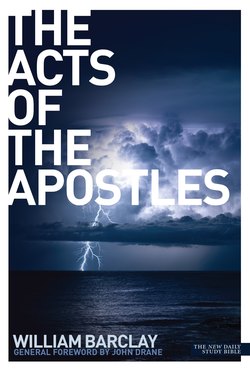Читать книгу The Acts of the Apostles - William Barclay - Страница 28
На сайте Литреса книга снята с продажи.
ОглавлениеBEFORE THE SANHEDRIN
Acts 4:5–12
So on the next day it happened that the rulers and the elders and the scribes were assembled in Jerusalem, together with Annas the high priest, and Caiaphas and John and Alexander and all those who belonged to the priestly families. So they set them in the midst and asked them: ‘By what power or by what name have you done this?’ Then Peter, filled with the Holy Spirit, said to them: ‘Rulers of the people and elders, if today we are being examined about the good deed done to the infirm man, if you are asking us by what means he has been restored to health, let it be known to all of you and to all the peoples of Israel that it is by the name of Jesus Christ of Nazareth, whom you crucified and whom God raised from the dead – it is by this name that this man stands before you in sound health. This is the stone which was set at naught by you builders, which has now become the head of the corner; and in no other is there salvation; for there is no other name under heaven, given among men, by which we must be saved.’
THE court before which Peter and John were brought was the Sanhedrin, the supreme court of the Jews. Even in Roman times, it had the right to arrest people. The one thing it could not do was to pass the death sentence, except in the single case of a Gentile who trespassed on the inner courts of the Temple.
The Sanhedrin had seventy-one members. The high priest was president because of his position. In the Sanhedrin there were priests, practically all of whom were Sadducees. Their one desire was to preserve the status quo so that their own benefits might not be lessened. There were scribes, who were the experts in the traditional law. There were Pharisees, who were fanatics for the law. There were elders, who were respected in the community.
There were also those described as being of ‘the priestly families’; these are the same people who are sometimes called chief priests. They consisted of two classes. First, there were ex-high priests. In the great days, the high priesthood had been hereditary and for life; but in the Roman times the office was the subject of intrigue, bribery and corruption, and high priests rose and fell, so that between 37 BC and AD 67 there were no fewer than twenty-eight. But even after a high priest had been deposed, he often remained the power behind the throne. Second, although the high priesthood had ceased to be hereditary, it was still the prerogative of a very few families. Of the twenty-eight high priests already mentioned, all but six came from four priestly families. The members of these families had a special status, and it is they who were known as the chief priests.
When we read Peter’s speech, and remember to whom it was spoken, we recognize one of the world’s great demonstrations of courage. It was spoken to an audience of the wealthiest, the most intellectual and the most powerful in the land – and yet Peter, the Galilaean fisherman, faces them rather as their judge than as their victim. Further, this was the very court which had condemned Jesus to death. Peter knew that he was taking his life in his hands.
There are two kinds of courage. There is the reckless courage, which is hardly aware of the dangers it is facing. There is the far higher, cool courage, which knows the peril in which it stands and refuses to be daunted. It was that second courage that Peter demonstrated. When Achilles, the great warrior of the Greeks, was told that if he went out to battle he would surely die, he answered in the immortal sentence: ‘Nevertheless, I am for going on.’ Peter, in that moment, knew the peril in which he stood; nevertheless, he, too, was for going on.
